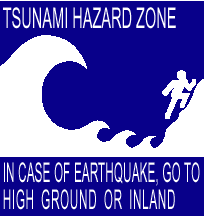Tsunamis
Newport Beach Tsunami Tri-fold
NOAA "Great Waves" Booklet
Tsunami Maps (scroll down to view)
Tsunami Video
Recommend NOAA Weather Radio
Tsunamis are the so-called “tidal waves” generated by some earthquakes. When you hear a tsunami warning, you must assume a dangerous wave is on its way. History shows that when great waves finally strike, they claim those who have ignored the warning.
1. All earthquakes do not cause tsunamis, but many do. If you live along the coast, on Newport Peninsula, or one of the islands in Newport Harbor, when you feel an earthquake or hear that an earthquake has occurred, evacuate immediately to higher ground . If you are on the beach, go inland to higher ground. The reason is that if you feel the earthquake, it is less than 50 miles distant. At that distance, it can reach the coast in 15 minutes or less. Take a portable radio with you and listen for updates.
2. An earthquake in your area is a natural tsunami warning. Leave the beach and low-lying coastal areas immediately if you feel an earthquake.
3. A tsunami is not a single wave, but a series of waves. Time between these great waves can be as long as 45 minutes from one wave to the next. Stay out of danger areas until the Newport Beach Police, Fire and/or Lifeguards issue an “all-clear”.
4. Approaching tsunamis are sometimes heralded by a noticeable rise or fall of coastal water. This is nature’s tsunami warning and should be heeded.
5. A small tsunami at one beach can be a giant wave a few miles away. Don’t let the modest size of one make you lose respect for all.
6. The Tsunami Warning System does not issue false alarms. When an ocean-wide warning is issued, a tsunami exists. When a regional warning is issued, a tsunami probably exists. Warnings can come from the Pacific Tsunami Warning center in Hawaii, or the Regional Warning Center located at Palmer, Alaska (Primary center that issues warnings for the Pacific Coast).
7. All tsunamis are potentially dangerous, even though they may not damage every coastline they strike.
8. Never go down to the beach to watch for a tsunami. When you can see the wave you may be too close to escape it. If you feel an earthquake or hear a Tsunami Warning, make sure your teenagers don’t go to the beach. Often times they believe they can surf the large waves. They must be educated to the fact that these waves can be deadly!
9. Sooner or later, tsunamis visit every coastline in the Pacific. Warnings apply to you if you live in any Pacific coastal area.
10. During a tsunami emergency, the Newport Beach Police, Fire, and Lifeguards will try to save your life. Give them your fullest cooperation and follow all emergency responders’ orders.
11. For more information on tsunamis, go to NOAA.
Stay tuned to your AM/FM radio or television stations during a tsunami emergency—bulletins issued through the Newport Beach Emergency Services Office and National Weather Service can help save your life!
Maps:
Safety, Service and Professionalism